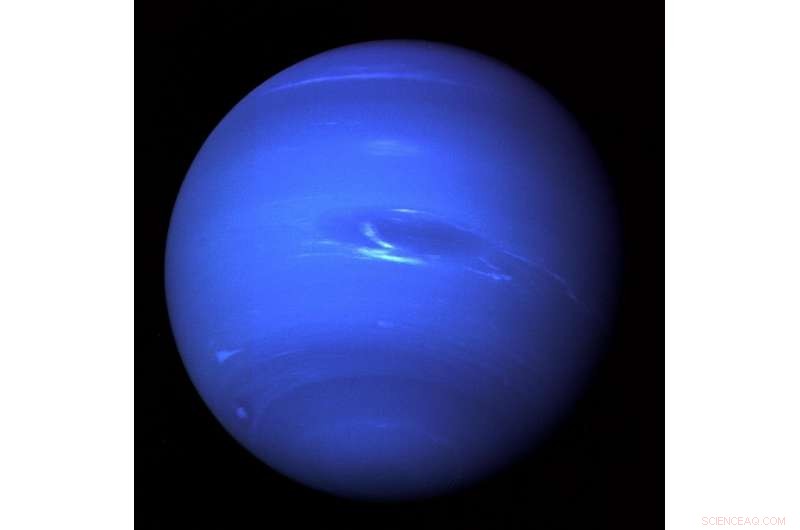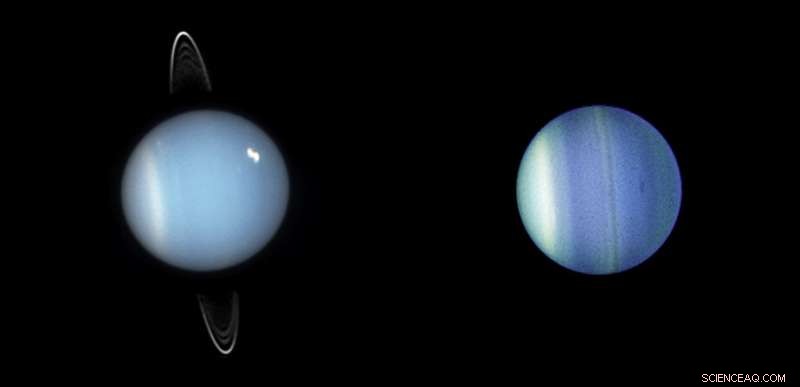
Cette image Voyager 2 de Neptune montre un monde froid et sombre fouetté par le vent. En 1989, Voyager 2 de la NASA est devenu le premier et le seul vaisseau spatial à observer la planète Neptune, passant environ 3, 000 milles au-dessus du pôle nord de la planète. Crédit :NASA/JPL-Caltech
Uranus et Neptune, les géants de glace de notre système solaire, sont aussi mystérieux que lointains. Peu après son lancement en 2021, Le télescope spatial James Webb de la NASA changera cela en révélant les secrets de l'atmosphère des deux planètes.
Les planètes géantes froides et éloignées Uranus et Neptune sont surnommées les "géantes de glace" parce que leurs intérieurs sont de composition différente de Jupiter et de Saturne, qui sont plus riches en hydrogène et en hélium, et sont connus comme les "géantes gazeuses". Les géantes de glace sont également beaucoup plus petites que leurs cousines gazeuses, étant de taille intermédiaire entre les planètes telluriques et les géantes gazeuses. Elles représentent la catégorie de planètes la moins explorée de notre système solaire. Les scientifiques utilisant Webb prévoient d'étudier les modèles de circulation, la chimie et la météo d'Uranus et de Neptune d'une manière que seul Webb peut.
"La chose clé que Webb peut faire c'est très, très difficile à réaliser à partir de toute autre installation est de cartographier leur température atmosphérique et leur structure chimique, " a expliqué le responsable des études, Leigh Fletcher, professeur agrégé de sciences planétaires à l'Université de Leicester au Royaume-Uni. "Nous pensons que la météo et le climat des géantes de glace vont avoir un caractère fondamentalement différent de celui des géantes gazeuses. C'est en partie parce qu'elles sont si loin du Soleil, ils sont plus petits et tournent plus lentement sur leurs axes, mais aussi parce que le mélange de gaz et la quantité de mélange atmosphérique sont très différents par rapport à Jupiter et Saturne."
Tous les gaz des hautes atmosphères d'Uranus et de Neptune ont des empreintes chimiques uniques que Webb peut détecter. Surtout, Webb peut distinguer un produit chimique d'un autre. Si ces produits chimiques sont produits par la lumière du soleil interagissant avec l'atmosphère, ou s'ils sont redistribués d'un endroit à l'autre par des schémas de circulation à grande échelle, Webb pourra le voir.
Ces études seront menées à travers un programme d'Observations à Temps Garanti (GTO) du système solaire dirigé par Heidi Hammel, un planétologue et un scientifique interdisciplinaire Webb. Elle est également vice-présidente pour la science à l'Association of Universities for Research in Astronomy (AURA) à Washington, Le programme de D.C. Hammel démontrera les capacités de Webb pour observer les objets du système solaire et exercera certaines des techniques spécifiques de Webb pour les objets brillants et/ou se déplaçant dans le ciel.
Uranus :la planète inclinée
Contrairement aux autres planètes de notre système solaire, Uranus - avec ses anneaux et ses lunes - est incliné sur le côté, tournant à un angle d'environ 90 degrés par rapport au plan de son orbite. Cela donne l'impression que la planète roule comme une boule autour du Soleil. Cette orientation étrange - qui peut être le résultat d'une collision gargantuesque avec une autre protoplanète massive au début de la formation du système solaire - donne lieu à des saisons extrêmes sur Uranus.
Lorsque le vaisseau spatial Voyager 2 de la NASA a survolé Uranus en 1986, un pôle pointait directement vers le Soleil. "Peu importe combien Uranus tournerait, " expliqua Hammel, "une moitié était en plein soleil tout le temps, et l'autre moitié était dans l'obscurité totale. It's the craziest thing you can imagine."
Disappointingly, Voyager 2 saw only a billiard-ball smooth planet covered in haze, with only a scant handful of clouds. But when Hubble viewed Uranus in the early 2000s, the planet had traveled a quarter of the way around in its orbit. Now the equator was pointed at the Sun, and the entire planet was illuminated over the course of a Uranian day.
"Theory told us nothing would change, " said Hammel, "But the reality was that Uranus started sprouting up all kinds of bright clouds, and a dark spot was discovered by Hubble. The clouds seemed to be changing dramatically in response to the immediate change in sunlight as the planet traveled around the Sun."

These Hubble Space Telescope images show the varied faces of Uranus. On the left, Uranus in 2005 displays its ring system. The planet -- along with its rings and moons -- is tipped on its side, rotating at roughly a 90-degree angle from the plane of its orbit. In the Hubble close-up taken just one year later, Uranus reveals its banded structure and a mysterious dark storm. Crédit :NASA, ESA, and M. Showalter (SETI Institute); Right:NASA, ESA, L. Sromovsky and P. Fry (U. Wisconsin), H. Hammel (Space Science Institute), and K. Rages (SETI Institute)
As the planet continues its slow orbital trek, it will point its other pole at the Sun in 2028.
Webb will give insight into the powerful seasonal forces driving the formation of its clouds and weather, and how this is changing with time. It will help determine how energy flows and is transported through the Uranian atmosphere. Scientists want to watch Uranus throughout Webb's life, to build up a timeline of how the atmosphere responds to the extreme seasons. That will help them understand why this planet's atmosphere seems to go through periods of intense activity punctuated by moments of calm.
Neptune:A World of Supersonic Winds
Neptune is a dark, cold world, yet it is whipped by supersonic winds that can reach up 1, 500 miles per hour. More than 30 times as far from the Sun as Earth, Neptune is the only planet in our solar system not visible to the naked eye. Its existence was predicted by mathematics before its discovery in 1846. In 2011, Neptune completed its first 165-year orbit since its discovery.
Like Uranus, this ice giant's very deep atmosphere is made of a thick soup of water, ammoniac, hydrogen sulfide and methane over an unknown and inaccessible interior. The accessible upper layers of the atmosphere are made of hydrogen, helium and methane. As with Uranus, the methane gives Neptune its blue color, but some still-mysterious atmospheric chemistry makes Neptune's blue a bit more striking than that of Uranus.
"It's the same question here:How does energy flow and how is it transported through a planetary atmosphere?" explained Fletcher. "But in this case, unlike Uranus, the planet has a strong internal heat source. That heat source generates some of the most powerful winds and the most short-lived atmospheric vortices and cloud features of anywhere in the solar system. If we look at Neptune from night to night, its face is always shifting and changing as these clouds are stretched and pulled and manipulated by the underlying wind field."
Following the 1989 Voyager 2 flyby of Neptune, scientists discovered a bright, hot vortex—a storm—at the planet's south pole. Because the temperature there is higher than everywhere else in the atmosphere, this region is likely associated with some unique chemistry. Webb's sensitivity will allow scientists to understand the unusual chemical environment within that polar vortex.
Just the Beginning
Fletcher advises to be prepared for seeing phenomena on Uranus and Neptune that are totally unlike what we've witnessed in the past. "Webb really has the capability to see the ice giants in a whole new light. But to understand the continual atmospheric processes that are shaping these giant planets, you really need more than just a couple of samples, " he said. "So we compare Jupiter to Saturn to Uranus to Neptune, and by that, we build up a wider picture of how atmospheres work in general. This is the beginning of understanding how these worlds are changing with time."
Hammel added, "We now know of hundreds of exoplanets—planets around other stars—of the size of our local ice giants. Uranus and Neptune provide us ground truth for studies of these newly discovered worlds."
The James Webb Space Telescope will be the world's premier space science observatory when it launches in 2021. Webb will solve mysteries in our solar system, regarder au-delà des mondes lointains autour d'autres étoiles, et sonder les structures et les origines mystérieuses de notre univers et notre place dans celui-ci. Webb is an international program led by NASA with its partners, ESA (Agence spatiale européenne) et l'Agence spatiale canadienne.